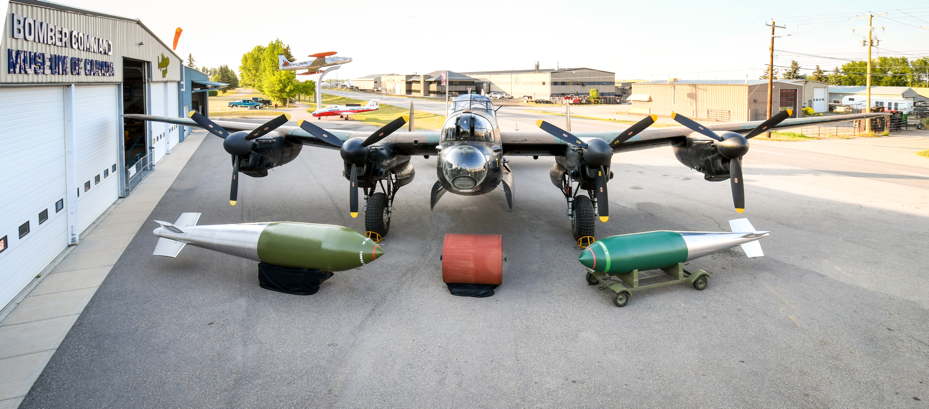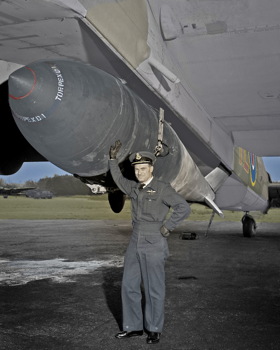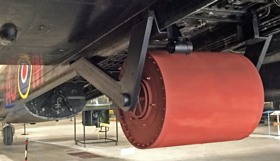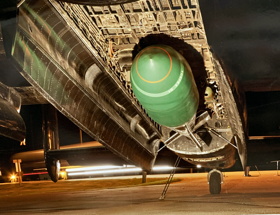 Bomber Command
Bomber Command  |
Aircrew Chronicles
|
Aircrew Losses
|
Nose Art
|
BCATP
|
Lancaster
|
Media
|
Aircrew Chronicles
|
Aircrew Losses
|
Nose Art
|
BCATP
|
Lancaster
|
Media
 Bomber Command
Bomber Command  |
Aircrew Chronicles
|
Aircrew Losses
|
Nose Art
|
BCATP
|
Lancaster
|
Media
|
Aircrew Chronicles
|
Aircrew Losses
|
Nose Art
|
BCATP
|
Lancaster
|
Media
|
Barnes Wallis was one of the most renown inventors and designers of the Second World War. Prior to the war, he had designed the famous Dirigible R- 100 which made a return trip across the Atlantic in 1930 and the Vickers Wellington, the most successful and widely used of the twin-engined bombers available to Bomber Command at the beginning of the war. The 'Wimpy' as it became known, pioneered the geodetic, or basket-weave form of aircraft construction. During the war, Wallis designed three special-purpose weapons that were delivered by 617 Squadron. The Bomber Command Museum of Canada had constructed replicas of all three. They are on display in the museum, together with a taxiable Lancaster Bomber, the type that delivered them. |

|

|
Specially modified Lancasters were the only aircraft capable of delivering the Grand Slam. Like the Tallboy, the weapon utilized the gyro-controlled, SABS bomb sight, the most accurate of any used during WW II. With a weight of 22,400 pounds and length of 25.5 feet, the Grand Slam could penetrate deep into the ground or through up to six metres of reinforced concrete. Fuses delayed the detonation for up to an hour. Like the Tallboy, the explosion created an earthquake-like pressure wave that destroyed nearby structures by displacing their foundations. A total of 41Grand Slams were dropped during the closing months of the war, destroying railway viaducts and bridges, and submarine pens. |
Technically a mine, the 9500 pound Upkeep was the weapon used on the legendary 'Dambusters Raid'. Upkeep was released from the Lancaster 1350 feet from the dam, at an altitude of 60 feet, while flying at a speed of 230 miles per hour. When it struck the water, the weapon was rotating backwards at 500 rpm to maintain its stability and slow it down. It then skipped several times along the surface of the reservoir (and over torpedo nets which were in place to protect the dam), rolled down the wall, and exploded at a preset depth. The shock waves then frac- tured and weakened the wall, enabling the great weight of the water in the reservoir to push through and breach the dam. |
The hardened steel case of the 12,000 pound Tallboy had a thickness of more than 4 inches at the nose. Fins placed at a five degree angle caused the bomb to spin as it fell. This improved the aerodynamics and thus the accuracy. When released from 18,000 feet, Tallboys impacted at 750 mph. Dropped two days after D-Day, the first Tallboys caused extensive damage to the Saumur Railway Tunnel. This prevented enemy reinforcements from reaching the beaches of Normandy. A total of 854 Tallboys were dropped on heavily reinforced V-1 and V-2 rocket assembly and launch sites, submarine pens, tunnels, oil refining and storage sites, viaducts, canals, and bridges. Its most spectacular success was the sinking of the Battleship Tirpitz, sister ship to the Bismarck. |
 Attend the museum's 'Salute to Johnny Fauquier' event on August 22nd to see the museum's Grand Slam replica in the museum's Lancaster's bomb-bay. |
 The museum's Upkeep replica in the museum's Lancaster's bomb-bay for our 75th Anniversary commemoration of the Dams Raid. |
 The museum's Tallboy replica in the museum's Lancaster's bomb-bay for our 70th Anniversary commemoration of the sinking of the Tirpitz. |